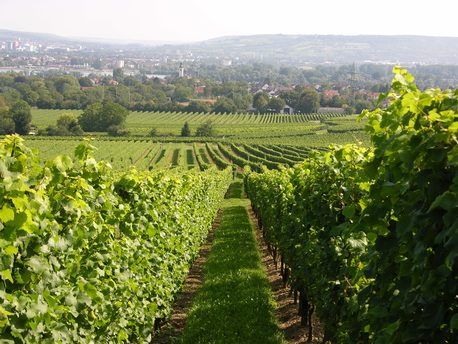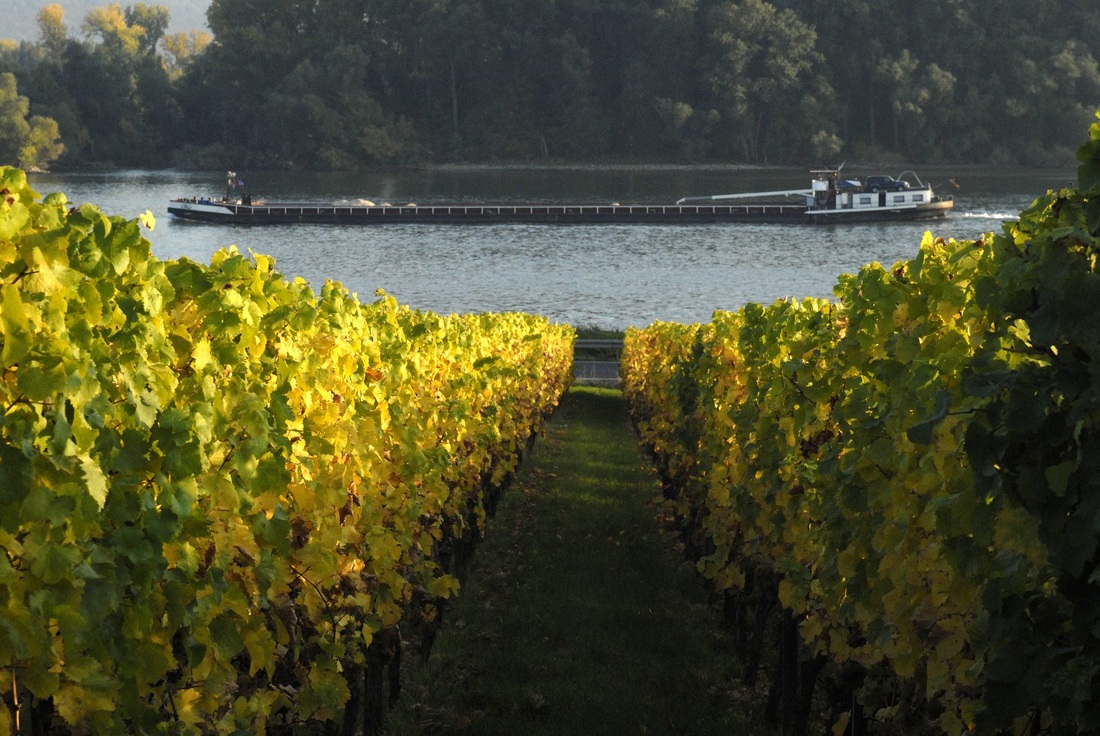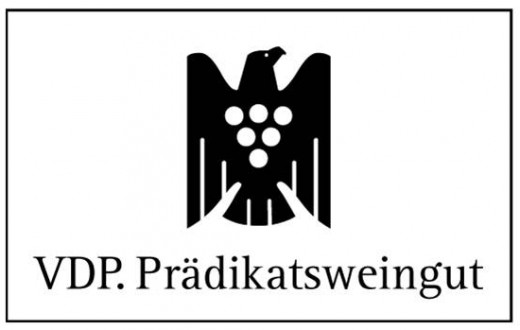n
The Baggage
Before getting started it’s probably best to deal with the various myths surrounding German wine. Here are the most common ones and the facts.
Myth: all German wine is white, fruity, innocuous, and cloyingly sweet.
Reality: thank you, Blue Nun. In fact, over 90% of the wine consumed in Germany is dry and a more than a bit of it red. Best examples of the old school fruity styled wine with residual sugar are largely exported to countries like Switzerland, the U.S., Japan and others. While there is still a great deal of mass-produced schlock that finds its way on to foreign retail shelves it’s easy to navigate around it. How? Start by looking for the VDP logo on the label or capsule.
Myth: the German language is soooo difficult to pronounce.
Reality: Seriously? If you can say Pacherenc du Vic–Bilh or Vino Nobile di Montepulciano you can say anything in German. Yes, it takes a bit of practice, but with few exceptions (most notably the “ei” “ie” combinations) the Germans pronounce every vowel and consonant making the language fairly straight forward. However, if you don’t practice and completely mispronounce something table side to a guest or during an exam you’ll sound just as much like a dolt as if you were mispronouncing something in any other language. But take heed and comfort because there are pronunciation guides for all the major German terms on the Guild site (guildsomm.com) and other online resources as well. Practice!
Myth: the labels are impossible to read much less understand.
Reality: true once upon a time but generally not the case now. Most of the top producers have gone a long way to simplify their labels for the international, largely English-speaking market. Regardless of the design the fact is that German labels contain more information than wine from most other countries. That means it takes some effort on your part to decipher what’s there.
Myth: Germany is a cold place in terms of climate.
Reality: once true but much less so now. For the better part of two millennia getting grapes ripe has been a constant struggle in Germany because most of the major vineyard areas are right at 50° latitude. That seems to have changed since 1990 and proof can be seen in the number of outstanding vintages in the last 25 years. Know that climate change has affected Germany as a wine producing country more than any other and that’s because top quality wines are categorized not by place of origin but how ripe the grapes are at the time of harvest. More on this later.
Acreage under vine: as a country Germany has approximately 252K acres of vineyards—far less than the region of Bordeaux.
Scale of production: Germany’s entire annual production is only 25% that of France.
White vs. red wines: just over 60% of German wine produced is white. That’s down almost 20% in the last 25 years due partly to climate change but also because plantings of red grapes such as Pinot Noir (Spätburgunder in German) have increased significantly.
Grape Varieties: the Major Players
There are hundreds of different grapes grown throughout Germany and a majority of them are white. Here are the important ones:
White
Riesling: gets my votes as the world’s greatest white grape. Riesling is the most widely planted grape in Germany accounting for over 22% all acreage under vine. In Germany Riesling displays an extraordinarily wide range of aromatics and flavors and can be made in a wide range of styles, from the dry Grosses Gewächs bottlings to the ultra-sweet, rare Trockenbeerenauslesen.
Müller-Thurgau: once the most widely planted grape in country now usually destined for blends or jug wines. Some good single varietal bottlings are also made.
Silvaner: originally from Alsace, plantings of Silvaner (note the spelling vs. Alsace) are concentrated in Franconia. Here the grape excels under the guidance of producers like Hans Wirsching.
Scheurebe: a Riesling-Silvaner cross that resembles part Gewürztraminer-part Riesling. Plantings of Scheurebe are on the decrease.
Weissburgunder (Pinot Blanc): increasingly popular in the post-sweet wine era of Germany. Plantings have increased by over 80% in the last 15 years.
Grauburgunder (Pinot Gris): focused in warner southern regions such as the Rheinhessen and the Pfalz. Plantings of Grauburgunder (literally “gray Burgundy”) have increased by over 90% in the last 15 years.
Red
Spätburgunder (Pinot Noir): there are dozens of red grapes commercially planted in Germany but Pinot Noir is by far the most important. Perhaps the true litmus test of climate change for Germany is the fact that the country now ranks third in plantings of the grape worldwide. The learning curve for quality is steep as well with a Spätburgunder from Ahr Valley producer Meyer-Näkel winning Decanter Magazine’s Pinot Noir of the year award in 2009.
Concepts You Should Know
The öchsle scale: the system used in Germany to measure the amount of grape sugar at harvest. Here the specific gravity or density of grape juice is compared to a similar amount of water. The difference—as in grape sugar and solids—is measured in degrees öchsle. Every quality level of German wine—from lowest to highest—has minimum öchsle requirements.
Village-Vineyard wine names: like Burgundy, top German wines are labeled with both the village and vineyard of their origin. For example, with a wine such as Bernkasteler Doctor from the Mosel, Bernkastel is the name of the village and Doctor the name of the vineyard. Note that the Germans usually add “er” to the name of the village like we would say New Yorkers are from New York. Remember, it’s just like Burgundy.
AMP number: every German quality wine must undergo Government tasting panel approval before commercial release. After approval, each wine is assigned an 11 digit tracking number of sorts called an AMP number (amtliche prüfungsnummer). The numbers identify the bottler’s village, individual code, application number, and year of application. All very precise—and very German.
Appellations: from Smallest to Largest
Einzellage (2,715): a single vineyard. Ein is the German word for “one” and—this is so completely German—there are as of last count 2,715 of them. Yes, unlike the Italians, the Germans can tell you exactly how many vineyards there are in country. I like that about them.
Grosslage (163): a collection of vineyards. Grosslage as an appellation dates from the 1971 changes to German wine law. It’s also arguably the Achilles heel, the major loophole, in German wine law because there is little, if any way, for a consumer to tell the difference between a wine bottled from one of the world’s great vineyards (i.e. einzellage) vs. a bottle of dreck made from a blend of less than stellar vineyard sources.
Bereich (34): a district made up of villages and vineyards; also dates from the ’71 wine laws.
Anbaugebiet (13): a major region and there are 13 of them. Anbaugebieten can easily be compared to the likes of Tuscany, Champagne, the Douro, and Priorat in their respective countries. The Mosel and the Rheingau are the two most historic and important anbaugebieten. More on these later.
Wine Classifications: from Least to Greatest
Tafelwein: table wine as in any wine bottled in Germany from grapes grown on planet earth.
Deutscher Tafelwein: wine bottled in Germany from German grapes.
Landwein: land wine. The equivalent of the French Vin de Pays. There are Landwein regions and requirements you can look up later but for now just know this category exists.
Qualitätswein (formerly Qualitätswein bestimmter Anbaugebiete): this is where everyone’s hard drive starts to freeze up because of the long words. Stay with me! As always a quick examination of the language reveals quite a lot. In this case Qualitätswein means quality wine from one of the 13 designated anbaugebieten. QbA wines are important to the U.S. market. Estate wines (especially Rieslings) and Pinot Noirs from top producers are almost always designated QbA because—this is important—they can legally be chaptalized. FYI chaptalization is also legal for the other three previous classifications as well.
Prädikatswein: quality wine with “attributes” or confirmed by the degree of ripeness at harvest. As I alluded to above, German wine laws are completely different from the French AOC/AOP model in that grape ripeness instead of place of origin is used as the sole arbiter for quality. Most of the top German wines we see in the U.S. are designated as Prädikatswein which means they cannot be chaptalized. Many are also produced from single vineyards.
Here in ascending order of ripeness–NOT residual sugar—are the six prädikate:
Kabinett: delicate and off-dry in style; made from fruit harvested early in the season.
Spätlese (late-harvest): slightly sweet in style. A Spätlese Riesling from a top vintage/producer/vineyard is capable of aging for decades. In fact, the oldest unfortified white wine I’ve ever tasted was a half-bottle of 80-year-old Spätlese from Rheinhold Haart in the Mosel. The magic combination of residual sugar, high acid, and low alcohol (7-9%) makes it one of the most versatile food-pairing wines as well.
Auslese (to select out): medium-sweet in style. Here is where botrytis often enters the picture and that means Auslesen Rieslings are a fantastic match for a wide range of cheeses. They also pair well with spicy cuisines such as Thai food. One of the great food and wine moments for me was an Erdener Prälat Auslese Riesling from Dr. Loosen paired with chili crab at the No-Signboard Restaurant in Singapore.
*WARNING! The three above prädikate can–by German law–be made into dry wines as in fermented completely dry. Thus a wine with the required must weight—amount of grape sugar at harvest—to be designated as Spätlese can be fermented dry and called “Spätlese Trocken (dry).” Leave it to the Germans to take a not-so-simple concept and make it exponentially more complex. Also note that members of the VDP (see below) are prohibited from using a prädikat and the term trocken on their labels because they have their own classification for dry wines. At least they have some sense.
The other three prädikate are often referred to as “noble sweet wines.” Two of the three are botrytis-influenced while the third is not.
Beerenauslese: to select out single grapes or berries. BA’s are they are called are always botrytis, luscious, and dessert sweet in style with tart balancing acidity. They’re also known for their great complexity and age-worthiness.
Eiswein: ice wine; as the name implies a wine made from partially frozen grapes harvested late in the season as in December or even January of the following year. By law, Eisweins must have the same must weight—amount of grape sugar—as Beerenauslesen hence their positioning in the prädikate hierarchy. But Eisweins are a completely different animal from BA’s or TBA’s simply because of the lack of botrytis influence. Eisweins often display remarkably high levels of acidity and like BA’s can age for a remarkably long period of time as in multiple decades—even in half-bottles.
Trockenbeerenauslese: the pinnacle of German quality wine. TBA’s are very rare vinous creatures only made in exceptional vintages. Intensely concentrated, lusciously sweet, and incredibly complex, they are labor-intensive to produce and accordingly very expensive. A winemaker in the Mosel once told me that it takes a person 8-10 hours a day to pick enough single, moldy, botrytis-infected grapes to make a 750ml bottle of BA and a 375ml bottle of TBA. One last point that needs to be addressed: why does the word “trocken,” as in the term for dry, appear in the name of the sweetest wine? Simple answer: the fruit is so raisinated from botrytis that there is little, if any, juice in the grapes to press.
A quick check of the six prädikate concept and entire German system where quality is based on grape sugar at harvest quickly reveals some troubling conclusions: great historic vineyard sources became irrelevant overnight and potential was created for making TBA from a secondary grape that still could find its way into the top tier of quality wine. To the latter point I remember the very first German wine I tasted in the late 1970’s. It was a 1976 BA made from the not-so-world famous Ortega grape from a producer in the Pfalz. The wine was syrupy sweet and smelled somewhere between a Glade plug-in air freshener and Aqua Velva. World class it definitely was not.
Enter the VDP, or Verband Deutscher Prädikatsweingüter, an association of Germany’s best producers founded in 1910. Today the VDP has just 200 members from all 13 regions. Given that over 30,000 entities grow grapes and make wine in Germany, it can easily be argued that the organization is the best of its kind in the world. It also goes without saying that the VDP’s regulations and classification are far more stringent than typical German laws.
Originally the VDP promoted sustainable agricultural practices and un-chaptalized wines from member producers that were featured at an annual auction. With the passing of the ’71 laws, its mission expanded and the organization sought to return the Germany’s great vineyards to their former prominence as well as the reputation of the country’s great dry wines. Over time the organization created its own classification that would seek to accomplish both. In 2002 the VDP published the first version of their classification which was updated in 2006 and again in 2012. As it now stands the classification, called “Grosse Lage” (not to be confused with the grosslage described previously), is based on the Burgundian system of Grand Cru and Premier Cru vineyards. The four tiered system is as follows:
• Grosse Gewächs: Grand Cru vineyards
• Erste Gewächs: Premier Cru vineyards
• Ortsweine: village level wines
• Gutsweine: traditional estate wines
The best dry wines from top vineyard sites are called “Grosses Gewächs,” roughly translated as Grand Cru. Wines designated as such carry a “GG” embossing on the bottle and only the name of the vineyard vs. the traditional village-vineyard combination noted above. GG wines follow far stricter regulations than typical German wines including mandatory hand harvesting, minimum must weights (Spätlese level), and lower yields (50 hectoliters per hectare).
Each regional VDP association is now in the process of reviewing sites in its own area to determine if they will be classified Grosse Gewächs or Erste Gewächs. It’s also important to note that not all 13 regions signed off on the four tiered classification vs. the previous three tiered version from 2006. Not a surprise given the fact that the VDP is a very political organization. It’s really no different than expecting the consorzios from Chianti Classico and Alto Adige to agree on anything.
Mosel
The Mosel is easily one of the most beautiful places in the world of wine. In particular, the Middle Mosel is a steep protected valley with vineyards of crumbling slate some of which are steeper than a black diamond ski slope. Riesling is king here and the wines combine purity of fruit, delicacy, high acidity and the unmistakable terroir of the vineyard.
Top vineyards: Erdener Prälat, Ürziger Würzgarten, Wehlener Sonnenuhr, Bernkasteler Doctor, Brauneberger Juffer Sonnenuhr, Piesporter Goldtröpchen
Producers: Dr. Loosen, J.J. Prüm, Wegeler, Frtiz Haag, Rheinhold Haart
Rheingau
The Rheingau is considered by most to be Germany’s most historic and important region. Here the Rhein River turns east/northeast offering the vineyards a perfect southerly exposure. Like the Mosel, Riesling is by far the most important grape here but the relatively warmer climate makes for riper grapes, a richer wine style, and proliferation of outstanding dry wines—as in Grosses Gewächs—from top vineyard sites. There are also two places in the Rheingau—Assmanshausen and Hochheim—where Pinot Noir ripens successfully every year.
Top vineyards: Rüdesheim Berg Schlossberg, Schloss Johannisberg, Schloss Vollrads, Erbacher Marcobrunn, Kiedricher Gräfenberg, Hochheimer Hölle
Producers: Robert Weil, Schloss Vollrads, Schloss Schönborn, Langwerth von Simmern, Franz Künstler
Rheinhessen
The Rheinhessen is literally just across the river from the Rheingau and the largest of Germany’s 13 regions. The region is also a land of extremes being at once the home of Liebfraumilch as well as the Nackenheimer Rothenberg, one of Germany’s great vineyards. Riesling is not as widely planted here but the style of Rheinhessen Rieslings is opulent, powerful, and racy. The best vineyards are concentrated in three villages bordering the Rhein in the northeast of the region near the beautiful medieval city of Mainz.
Top vineyards: Nackenheimer Rothenberg, Niersteiner Hipping, Niersteiner Pettenthal, Oppenheimer Sackträger, Westhofener Morstein
Producers: Gunderloch, Keller, Wittmann, Wagner-Stempel
Pfalz
Called the Rheinpfalz until 1992, the Pfalz region is located near Alsace in southern Germany. Like Alsace, the Haardt Mountains in the Pfalz create a rain shadow effect making it the warmest, driest place in the entire country. The range of grape varieties grown here is more varied compared to more northerly growing areas. Pfalz Rieslings, many of them top quality dry wines, are among the most opulent, powerful, and complex whites in Germany. Also worth seeking out are excellent Weissburgunders, Grauburgunders, and Spätburgunders.
Top vineyards: Forster Kirchenstück, Forster Ungeheuer, Forster Jesuitengarten, Deidesheimer Langenmorgen, Deidesheimer Hohenmorgen, Ruppertsberger Reiterpfad, Kallstader Saumagen
Producers: Basserman-Jordan, Bürklin-Wolf, von Buhl, Müller-Catoir
Nahe
The Nahe is located due west of the Rheingau and considered by many to be the most beautiful part of Germany. Here Riesling is the most important grape and the wine style often described as combining the delicacy of Mosel wines with the power and elegance of the Rheingau.
Top vineyards: Niederhauser Hermannshöhle, Oberhauser Brücke, Schlossböckelheimer Kupfergrube, Schlossböckelheimer Felsenberg
Producers: Dönnhoff, Schlossgut Diel, Emrich Schönleber
Ahr Valley
The tiny Ahr Valley in north-central Germany is one of the anomalies—free electrons—of the wine world. Located at 50° latitude at the very outer limit where Vitis vinifera can be grown, over 80% of the grapes planted here are red and Pinot Noir by far the most important. Oddly enough, the Ahr is actually warmer overall than the Mosel because it’s protected by the Eifel Mountains and its steep slopes of volcanic and slate soils face south and southwest acting as a sun trap. Meyer-Näkel and Kreuzberg are the two top producers of Spätburgunder here and their wines fetch considerable sums in Europe and abroad.
Franken
Franken or Franconia lies due east of Hochheim on the Main River. Although the region is known for its outstanding beer some excellent wines are made particularly from Silvaner. In fact, many argue the best examples of the Silvaner grape come the Franken region. In the spring during spargel season (white asparagus) Silvaner is the go to wine. Some Riesling is also grown here but the grape is challenged by the region’s cooler, wetter climate. Generally the wine styles produced in Franken are dry.
Top vineyards: Würzburger Stein, Iphofener Julius Echter Berg, Bürgstadter Centgrafenberg
Producers: Hans Wirsching, Horst Sauer
Wrapping Up
That’s the basics of German wine. If you still think Germany is difficult, think again. Stop for a moment and consider France and how different the 1855 Classification in Bordeaux is from the Échelle des Crus in Champagne and how different both are from the vineyard classifications in Burgundy. In other words, France–the so-called easy country–has multiple classifications for each different regional AOC/AOP compared to Germany with one classification for all the country’s 13 regions and a further quality classification for the VDP. Not so bad after all. Prost!
And drink more German Riesling.
Always.
nn



